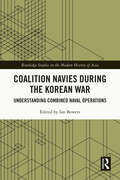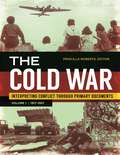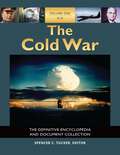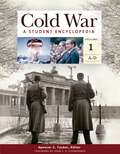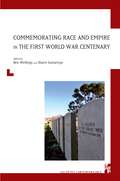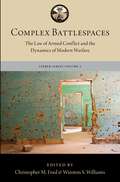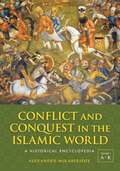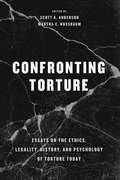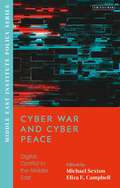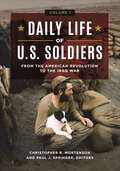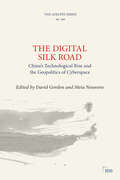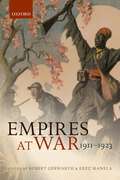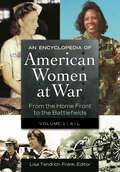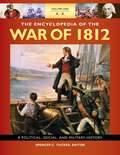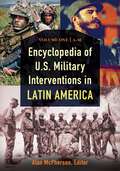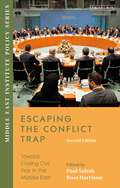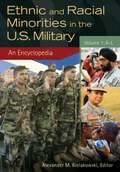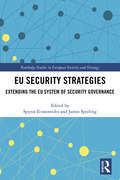- Table View
- List View
Coalition Navies during the Korean War: Understanding Combined Naval Operations (Routledge Studies in the Modern History of Asia)
This book presents a detailed assessment of the role of navies in the Korean War. It highlights that, despite being predominantly a land war, navies played a vital part. Moreover, the naval war was not solely a U.S. operation. Smaller navies from many countries made important contributions both in supporting the United States and carrying out independent and combined naval operations. This subject holds special importance since current Western strategic thinking and capabilities emphasise the necessity of combined naval operations involving multiple navies in any potential future naval conflict. The example set by the Korean War therefore offers valuable insights into the operational and strategic problems, and benefits and opportunities of contemporary and future combined coalition naval operations.
The Cold War [2 volumes] [2 volumes]: 2 volumes [2 volumes]
This detailed two-volume set tells the story of the Cold War, the dominant international event of the second half of the 20th century, through a diverse selection of primary source documents.One of the most extensive to date, this set of primary source documents studies the Cold War comprehensively from its beginning, with the emergence of the world's first communist government in Russia in late 1917, to its end, in 1991. All of the key events, including the Berlin Blockade, the Korean War, the Cuban Missile Crisis, the Vietnam War, and the nuclear arms race, are discussed in detail. The primary sources provide insight into the thinking of all participants, drawing on Western, Soviet, Asian, and Latin American perspectives.In The Cold War: Interpreting Conflict through Primary Documents primary documents are organized chronologically, allowing readers to appreciate the ramifications of the Cold War within a clear time frame. Extensive interpretive commentary provides in-depth background and context for each document. This work is an indispensable reference for all readers seeking to become deeply knowledgeable about the Cold War.
The Cold War [5 volumes]: The Definitive Encyclopedia and Document Collection [5 volumes]
This sweeping reference work covers every aspect of the Cold War, from its ignition in the ashes of World War II, through the Berlin Wall and the Cuban Missile Crisis, to the collapse of the Soviet Union in 1991.The Cold War superpower face-off between the Soviet Union and the United States dominated international affairs in the second half of the 20th century and still reverberates around the world today. This comprehensive and insightful multivolume set provides authoritative entries on all aspects of this world-changing event, including wars, new military technologies, diplomatic initiatives, espionage activities, important individuals and organizations, economic developments, societal and cultural events, and more. This expansive coverage provides readers with the necessary context to understand the many facets of this complex conflict.The work begins with a preface and introduction and then offers illuminating introductory essays on the origins and course of the Cold War, which are followed by some 1,500 entries on key individuals, wars, battles, weapons systems, diplomacy, politics, economics, and art and culture. Each entry has cross-references and a list of books for further reading. The text includes more than 100 key primary source documents, a detailed chronology, a glossary, and a selective bibliography. Numerous illustrations and maps are inset throughout to provide additional context to the material.
Cold War [5 volumes]: A Student Encyclopedia [5 volumes]
The most comprehensive and up-to-date student reference on the Cold War, offering expert coverage of all aspects of the conflict in a richly designed format, fully illustrated to give students a vivid sense of life in all countries affected by the war.ABC-CLIO is proud to announce the latest addition to its widely acclaimed legacy of historical reference works for students. Under the direction of internationally known expert Spencer Tucker, Cold War: A Student Encyclopedia captures the vast scope, day-to-day drama, and lasting impact of the Cold War more clearly and powerfully than any other student resource ever published.Ranging from the end of the Second World War to the collapse of the Soviet Union, Cold War: A Student Encyclopedia offers vivid portrayals of leading individuals, significant battles, economic developments, societal/cultural events, changes in military technology, and major treaties and diplomatic agreements. The nearly 1,100 entries, plus topical essays and a documents volume, draw heavily on recently opened Russian, Eastern European, and Chinese archives. Enhanced by a rich program of maps and images, it is a comprehensive, current, and accessible student reference on the dominant geopolitical phenomenon of the late-20th century.
Commemorating Race and Empire in the First World War Centenary (Provence University Press)
First World War commemoration in Europe has been framed as a moment of national trial and as a collective European tragedy. But the ‘Great War for Civilisation’ was more than just a European conflict. It was in fact a global war, a clash of empires that began a process of nationalist agitation against imperial polities and the racisms that underpinned them in Asia, Africa and beyond. Despite the global context of Centenary commemorative activity these events remain framed by national and state imaginaries and ones in which the ideas about nation, race and imperialism that animated and dominated men and women during the Great War sit uncomfortably with modern sensibilities. By drawing on original archival research, translations from French and Mandarin into English and by employing multidisciplinary conceptual frames of analysis this exciting and innovative volume explores how race and empire, and racism and imperialism, were commemorated or forgotten during the First World War Centenary.
Complex Battlespaces: The Law of Armed Conflict and the Dynamics of Modern Warfare (The Lieber Studies Series)
The conduct of warfare is constantly shaped by new forces that create complexities in the battlespace for military operations. As the nature of how and where wars are fought changes, new challenges to the application of the extant body of international law that regulates armed conflicts arise. This inaugural volume of the Lieber Studies Series seeks to address several issues in the confluence of law and armed conflict, with the primary goal of providing the reader with both academic and practitioner perspectives. Featuring chapters from world class scholars, policymakers and other government officials; military and civilian legal practitioners; and other thought leaders, together they examine the role of the law of armed conflict in current and future armed conflicts around the world. Complex Battlespaces also explores several examples of battlespace dynamics through four "lenses of complexity": complexity in legal regimes, governance, technology, and the urbanization of the battlefield.
Conflict and Conquest in the Islamic World [2 volumes] [2 volumes]: 2 volumes [2 volumes]
A reference work that thoroughly documents the extensive military history of the Islamic world between the 7th century and the present day.Military-political conflict—and the resulting factionalism, shifts in leadership, and divergent belief systems—has been a constant and crucial part of the Islamic world. In order to fully grasp the cultural, social, or political aspects of Islam in the modern world, it is necessary to comprehend the rich tapestry of Islamic history from pre-Islamic times to the present, much of which involved armed conflict.Conflict and Conquest in the Islamic World: A Historical Encyclopedia provides hundreds of entries on wars, revolutions, sieges, institutions, leaders, armies, weapons, and other aspects of wars and military life, enabling readers to understand the complex role conflict has played in Islamic life throughout history and see how Islamic warfare has evolved over the centuries. This reference work covers not only the traditional Middle Eastern regions and countries but also provides relevant historical information regarding Islam in North Africa, Central Asia, Southeastern Asia, and Oceania.
Confronting Torture: Essays on the Ethics, Legality, History, and Psychology of Torture Today
Torture has lately become front page news, featured in popular movies and TV shows, and a topic of intense public debate. It grips our imagination, in part because torturing someone seems to be an unthinkable breach of humanity—theirs and ours. And yet, when confronted with horrendous events in war, or the prospect of catastrophic damage to one’s own country, many come to wonder whether we can really afford to abstain entirely from torture. Before trying to tackle this dilemma, though, we need to see torture as a multifaceted problem with a long history and numerous ethical and legal aspects. Confronting Torture offers a multidisciplinary investigation of this wrenching topic. Editors Scott A. Anderson and Martha C. Nussbaum bring together a diversity of scholars to grapple with many of torture’s complexities, including: How should we understand the impetus to use torture? Why does torture stand out as a particularly heinous means of war-fighting? Are there any sound justifications for the use of torture? How does torture affect the societies that employ it? And how can we develop ethical or political bulwarks to prevent its use? The essays here resist the temptation to oversimplify torture, drawing together work from scholars in psychology, history, sociology, law, and philosophy, deepening and broadening our grasp of the subject. Now, more than ever, torture is something we must think about; this important book offers a diversity of timely, constructive responses on this resurgent and controversial subject.
Cyber War and Cyber Peace: Digital Conflict in the Middle East (Middle East Institute Policy Series)
The Middle East is the region in which the first act of cyber warfare took place. Since then, cyber warfare has escalated and has completely altered the course of the MENA region's geopolitics.With a foreword by top national security and cyber expert, Richard A. Clarke, this is the first anthology to specifically investigate the history and state of cyber warfare in the Middle East. It gathers an array of technical practitioners, social science scholars, and legal experts to provide a panoramic overview and cross-sectional analysis covering four main areas: privacy and civil society; the types of cyber conflict; information and influence operations; and methods of countering extremism online. The book highlights the real threat of hacktivism and informational warfare between state actors and the specific issues affecting the MENA region. These include digital authoritarianism and malware attacks in the Middle East, analysis of how ISIS and the Syrian electronic army use the internet, and the impact of disinformation and cybercrime in the Gulf. The book captures the flashpoints and developments in cyber conflict in the past 10 years and offers a snapshot of the region's still-early cyber history. It also clarifies how cyber warfare may develop in the near- to medium-term future and provides ideas of how its greatest risks can be avoided.
Daily Life of U.S. Soldiers [3 volumes]: From the American Revolution to the Iraq War [3 volumes]
This ground-breaking work explores the lives of average soldiers from the American Revolution through the 21st-century conflicts in Afghanistan and Iraq.What was life really like for U.S. soldiers during America's wars? Were they conscripted or did they volunteer? What did they eat, wear, believe, think, and do for fun? Most important, how did they deal with the rigors of combat and coming home? This comprehensive book will answer all of those questions and much more, with separate chapters on the American Revolution, the War of 1812, the Mexican-American War, the Civil War, the Indian Wars, the Spanish-American War, World War I, World War II in Europe, World War II in the Pacific, the Cold War, the Korean War, the Vietnam War, the Persian Gulf War, the Afghanistan War and War on Terror, and the Iraq War.Each chapter includes such topical sections as Conscription and Volunteers, Training, Religion, Pop Culture, Weaponry, Combat, Special Forces, Prisoners of War, Homefront, and Veteran Issues. This work also examines the role of minorities and women in each conflict as well as delves into the disciplinary problems in the military, including alcoholism, drugs, crimes, and desertion. Selected primary sources, bibliographies, and timelines complement the topical sections of each chapter.
The Digital Silk Road: China’s Technological Rise and the Geopolitics of Cyberspace (Adelphi series)
Concerns about China’s ambitions to return to global centre stage as a great power have recently begun to focus on the Digital Silk Road (DSR), an umbrella term for various activities – commercial and diplomatic – of interest to the Chinese government in the cyber realm. Part of (or a spin-off from) the 2013 Belt and Road Initiative, by 2020 the DSR had become a focal point of China’s foreign policy. But the DSR remains ill-defined and poorly understood. At the heart of such concerns is not that Chinese technology companies are becoming globally competitive, but rather that Beijing could use them to ‘rewire’ the global digital architecture, from physical cables to code. Dominance by Chinese technology could shift global norms from a free cyber commons to competing systems of cyber sovereignty or cyber freedom. This Adelphi book brings together eight experts to examine the development of the DSR, explore its impact on economics, security and governance in recipient countries, and assess the broader impact on patterns of economic and technological dependence, on the emerging rules and norms of tech globalisation, and on global geopolitics and great-power relations. Beijing has grasped the opportunity to leverage the entrepreneurial strengths of its private tech sector to gain prominence in the world’s digital ecosystem. But the more interventionist Beijing becomes, the more Chinese firms will be seen as instruments of the state, and the greater the pushback against Chinese technology and the DSR may be. To achieve great-power status and global centrality, Beijing might ultimately need to change tack. How it innovates in further rolling out Chinese tech across the world, and what the DSR will then look like, will have far-reaching impacts on global economics, politics and security.
Dotawo: War in the Sudan
Dotawo: A Journal of Nubian Studies offers a platform in which the old meets the new, in which archaeological, papyrological, and philological research into Meroitic, Old Nubian, Coptic, Greek, and Arabic sources confront current investigations in modern anthropology and ethnography, Nilo-Saharan linguistics, and the critical and theoretical approaches of postcolonial and African studies. Dotawo gives a common home to the past, present, and future of one of the richest areas of research in African studies. It offers a crossroads where papyrus can meet the internet, scribes meet critical thinkers, and the promises of growing nations meet the accomplishments of older kingdoms. The eighth issue of Dotawo aims to offer new insights into violent conflicts and wars in Sudan through time and across the region. Special attention is devoted to research on Nubia. The authors use archaeological, historical, philological, and artistic sources to investigate war in the Sudan from the 4th millennium BCE until the present day.
Electric Motor (Large Print)
In these diagrams of an electric motor, there is an end view on the left of the page and a top view on the right of the page, separated by a vertical dashed line. There is a locator dot shown, which will be at the top left of the page when the image is the right way up. On the end view there is a permanent magnet of south polarity on the left of the page. To the right of this is a large circle which has four electro-magnets around its outer edge. Inside the circle are some thick lines which represent electrical wires that connect the magnets in pairs. Only the wiring connecting one pair of electro-magnets is shown. In the centre is the commutator with the axle in its centre. To the bottom left and upper right of the commutator are the electrical brushes with wires going to the battery (which is not shown). On the far right of the page is a permanent magnet of north polarity. The top view on the right of the page shows the commutator in the bottom right of the page with a single brush. Up from this the electro-magnets are shown. In the end view the permanent magnets to the left and right of the page remain static. The brushes and the wires to the battery also remain static. The electro-magnets, their wiring and the commutator rotate on the axle. The image shows the moment when the positive brush, seen to the upper right of the commutator, supplies electricity to a quadrant of the commutator. This quadrant can then supply electricity via the upper vertical wire to the electro-magnet at the top of the page. The current makes it magnetic with south polarity. This results in the electro-magnet being attracted to and rotating towards the permanent north magnet on the right of the page. The electricity from the charged south electro-magnet flows onwards to the electro-magnet on the opposite side of the diagram, at the bottom of the page, via the longer curved wire. The lower electro-magnet becomes magnetic with north polarity because of the direction of the wiring. This results in the electro-magnet rotating towards the permanent south magnet on the left of the page. The north polarity electro-magnet is currently connected via a vertical wire to a different quadrant of the commutator. As the negative brush contacts this the current can flow back to the battery thus completing the circuit. When this electro-magnet reaches the upper position it will be supplied with electricity again but flowing in the opposite direction so it will become an electro-magnet with south polarity. When the motor is running the pairs of electro-magnets are constantly being turned on and off by the commutator.
Electric Motor (UEB Contracted)
In these diagrams of an electric motor, there is an end view on the left of the page and a top view on the right of the page, separated by a vertical dashed line. There is a locator dot shown, which will be at the top left of the page when the image is the right way up. On the end view there is a permanent magnet of south polarity on the left of the page. To the right of this is a large circle which has four electro-magnets around its outer edge. Inside the circle are some thick lines which represent electrical wires that connect the magnets in pairs. Only the wiring connecting one pair of electro-magnets is shown. In the centre is the commutator with the axle in its centre. To the bottom left and upper right of the commutator are the electrical brushes with wires going to the battery (which is not shown). On the far right of the page is a permanent magnet of north polarity. The top view on the right of the page shows the commutator in the bottom right of the page with a single brush. Up from this the electro-magnets are shown. In the end view the permanent magnets to the left and right of the page remain static. The brushes and the wires to the battery also remain static. The electro-magnets, their wiring and the commutator rotate on the axle. The image shows the moment when the positive brush, seen to the upper right of the commutator, supplies electricity to a quadrant of the commutator. This quadrant can then supply electricity via the upper vertical wire to the electro-magnet at the top of the page. The current makes it magnetic with south polarity. This results in the electro-magnet being attracted to and rotating towards the permanent north magnet on the right of the page. The electricity from the charged south electro-magnet flows onwards to the electro-magnet on the opposite side of the diagram, at the bottom of the page, via the longer curved wire. The lower electro-magnet becomes magnetic with north polarity because of the direction of the wiring. This results in the electro-magnet rotating towards the permanent south magnet on the left of the page. The north polarity electro-magnet is currently connected via a vertical wire to a different quadrant of the commutator. As the negative brush contacts this the current can flow back to the battery thus completing the circuit. When this electro-magnet reaches the upper position it will be supplied with electricity again but flowing in the opposite direction so it will become an electro-magnet with south polarity. When the motor is running the pairs of electro-magnets are constantly being turned on and off by the commutator.
Electric Motor (UEB Uncontracted)
In these diagrams of an electric motor, there is an end view on the left of the page and a top view on the right of the page, separated by a vertical dashed line. There is a locator dot shown, which will be at the top left of the page when the image is the right way up. On the end view there is a permanent magnet of south polarity on the left of the page. To the right of this is a large circle which has four electro-magnets around its outer edge. Inside the circle are some thick lines which represent electrical wires that connect the magnets in pairs. Only the wiring connecting one pair of electro-magnets is shown. In the centre is the commutator with the axle in its centre. To the bottom left and upper right of the commutator are the electrical brushes with wires going to the battery (which is not shown). On the far right of the page is a permanent magnet of north polarity. The top view on the right of the page shows the commutator in the bottom right of the page with a single brush. Up from this the electro-magnets are shown. In the end view the permanent magnets to the left and right of the page remain static. The brushes and the wires to the battery also remain static. The electro-magnets, their wiring and the commutator rotate on the axle. The image shows the moment when the positive brush, seen to the upper right of the commutator, supplies electricity to a quadrant of the commutator. This quadrant can then supply electricity via the upper vertical wire to the electro-magnet at the top of the page. The current makes it magnetic with south polarity. This results in the electro-magnet being attracted to and rotating towards the permanent north magnet on the right of the page. The electricity from the charged south electro-magnet flows onwards to the electro-magnet on the opposite side of the diagram, at the bottom of the page, via the longer curved wire. The lower electro-magnet becomes magnetic with north polarity because of the direction of the wiring. This results in the electro-magnet rotating towards the permanent south magnet on the left of the page. The north polarity electro-magnet is currently connected via a vertical wire to a different quadrant of the commutator. As the negative brush contacts this the current can flow back to the battery thus completing the circuit. When this electro-magnet reaches the upper position it will be supplied with electricity again but flowing in the opposite direction so it will become an electro-magnet with south polarity. When the motor is running the pairs of electro-magnets are constantly being turned on and off by the commutator.
Empires at War: 1911-1923 (The Greater War)
Empires at War, 1911-1923 offers a new perspective on the history of the Great War. It expands the story of the war both in time and space to include the violent conflicts that preceded and followed the First World War, from the 1911 Italian invasion of Libya to the massive violence that followed the collapse of the Ottoman, Russian, and Austrian empires until 1923. It also presents the war as a global war of empires rather than a a European war between nation-states. This volume tells the story of the millions of imperial subjects called upon to defend their imperial governments' interest, the theatres of war that lay far beyond Europe, and the wartime roles and experiences of innumerable peoples from outside the European continent. Empires at War covers the broad, global mobilizations that saw African solders and Chinese labourers in the trenches of the Western Front, Indian troops in Jerusalem, and the Japanese military occupying Chinese territory. Finally, the volume shows how the war set the stage for the collapse not only of specific empires, but of the imperial world order writ large.
An Encyclopedia of American Women at War [2 volumes]: From the Home Front to the Battlefields [2 volumes]
A sweeping review of the role of women within the American military from the colonial period to the present day.In America, the achievements, defeats, and glory of war are traditionally ascribed to men. Women, however, have been an integral part of our country's military history from the very beginning. This unprecedented encyclopedia explores the accomplishments and actions of the "fairer sex" in the various conflicts in which the United States has fought.An Encyclopedia of American Women at War: From the Home Front to the Battlefields contains entries on all of the major themes, organizations, wars, and biographies related to the history of women and the American military. The book traces the evolution of their roles—as leaders, spies, soldiers, and nurses—and illustrates women's participation in actions on the ground as well as in making the key decisions of developing conflicts. From the colonial conflicts with European powers to the current War on Terror, coverage is comprehensive, with material organized in an easy-to-use, A–Z, ready-reference format.
The Encyclopedia of North American Colonial Conflicts to 1775 [3 volumes]: A Political, Social, and Military History [3 volumes]
The only multivolume encyclopedia covering all aspects of North American colonial warfare, with special attention paid to the social, political, cultural, and economic affairs that were affected by the conflicts.Encyclopedia of North American Colonial Conflicts to 1775: A Political, Social, and Military History is the first multivolume resource on the full range of combat and confrontation in the New World prior to the American Revolution—not just rivalries between European empires but Indian conflicts, slave rebellions, and popular uprisings as well.Organized A–Z, the encyclopedia covers all major wars and conflicts in North America from the late-15th to mid-18th centuries, with discussions of key battles, diplomatic efforts, military technologies, and strategies and tactics. Encyclopedia of North American Colonial Conflicts to 1775 explores the context for conflict, with essays on competing colonial powers, every major Native American tribe, all important political and military leaders, and a range of social and cultural issues. The insights and information contained here will help anyone understand the genesis of North American culture, the plight of Native Americans after European contact, and the beginnings of the United States of America.
The Encyclopedia of the Arab-Israeli Conflict [4 volumes] [4 volumes]: 4 volumes [4 volumes]
This exhaustive work offers readers at multiple levels key insights into the military, political, social, cultural, and religious origins of the Arab-Israeli conflict.The Encyclopedia of the Arab-Israeli Conflict: A Political, Social, and Military History is the first comprehensive general reference encompassing all aspects of the contentious Arab-Israeli relationship from biblical times to the present, with an emphasis on the era beginning with World War I.The Encyclopedia of the Arab-Israeli Conflict goes beyond simply recapping military engagements. In four volumes, with more than 750 alphabetically organized entries, plus a separate documents volume, it provides a wide-ranging introduction to the distinct yet inextricably linked Arab and Israeli worlds and worldviews, exploring all aspects of the conflict. The objective analysis will help readers understand the dramatic events that have impacted the entire world, from the founding of modern Israel to the building of the Suez Canal; from the Six-Day War to the Camp David Accords; from the assassinations of Anwar Sadat and Yitzhak Rabin to the rise and fall of Yasser Arafat, the 2006 Palestinian elections, and the Israeli-Hezbollah War in Lebanon.
Encyclopedia of the Veteran in America [2 volumes]: [2 volumes]
A comprehensive encyclopedia that describes the experiences of American veterans from the Revolutionary War to the present.From the American Revolution to today's conflicts in Iraq and Afghanistan, Encyclopedia of the Veteran in America captures the experiences and lives of our nation's veterans in a comprehensive, unprecedented way. It is the first major reference work focused exclusively on an American soldier's view of military life during war and the often difficult return to civilian life and peacetime afterward.Encyclopedia of the Veteran in America comprises over 100 insightful entries that include major examinations of the American Revolution, Civil War, World Wars I and II, Korean War, Vietnam War, and the Gulf, Afghan, and Iraq Wars, plus brief reviews of other conflicts. In addition, it highlights the specific experiences of POW, MIAs, and their families, as well as African Americans, women, and American Indian soldiers. Additional entries focus on key historic figures like Theodore Roosevelt and General Douglas MacArthur, veterans' organizations like the American Legion and the VFW, legislative initiatives, and the full range of memorials and monuments dedicated to our fighting men and women.
The Encyclopedia of the War of 1812 [3 volumes]: A Political, Social, and Military History [3 volumes]
This work is the most comprehensive reference work on the War of 1812 yet published, offering a multidisciplinary treatment of course, causes, effects, and specific details of the War that provides both quick reference and in-depth analysis for readers from the high school level to scholars in the field.The Encyclopedia of the War of 1812: A Political, Social, and Military History dedicates 872 entries—totaling some 600,000 words—to this important American war. It is the most comprehensive and significant reference work available on the subject. Its entries spotlight the key battles, standout individuals, essential weapons, and social, political, and economic developments, and examine the wider, concurrent European developments which directly affected this conflict in North America. A volume of primary documents provides more avenues for research.This three-volume work offers comprehensive, in-depth information in a format that lends itself to quick and easy use, making it ideal for high school, college, and university-level learners as well as general learning annexes and military libraries. Scholars of the period and students of American military history will find it essential reading.
Encyclopedia of U.S. Military Interventions in Latin America [2 volumes]: [2 volumes]
This unique reference shows how the United States has intervened militarily, politically, and economically in Central America, South America, and the Caribbean from the early 19th century to the present day.What do baseball, American war crimes, and a slice of watermelon have in common in the annals of Latin American history? Believe it or not, this disparate grouping reflects the cultural and historical remnants of America's military and political involvement in the region. As early as 1811, the United States began intervening in the affairs of Central America, South America, and the Caribbean … and it hasn't stopped since. This compelling reference analyzes both the major interventions and minor conflicts stemming from our nation's military operations in these areas and examines the people, places, legislation, and strategies that contributed to these events.In addition to documented facts and figures, the alphabetically organized entries in Encyclopedia of U.S. Military Interventions in Latin America present fascinating anecdotes on the subject, including why the United States once invaded Panama over a slice of watermelon, how an intervention in Nicaragua landed our country on trial for war crimes, and how the popularity of baseball in Latin America is a direct result of American influence. Primary source documents and visual aids accompany the content.
Escaping the Conflict Trap: Toward Ending Civil War in the Middle East (Middle East Institute Policy Series)
How can the current civil wars in the Middle East be resolved? This volume brings together academics, experts, and practitioners to explore this question. The book covers the history of civil wars in the region during the 20th century, and then examines the specific causes, drivers, and dynamics of the ongoing civil wars in Syria, Yemen, Libya, Afghanistan, and Iraq.Updated for a second edition, the book argues that while these are very different cases of civil war, there are patterns that are important to point out at the outset. First, while each of the conflicts appears to be a relatively recent phenomenon, each has a long historical tail. Second, each of the civil wars had deep and complex domestic drivers and dynamics over issues of governance, political identity, and resources; at the same time, all of the conflicts have had deep regional and international components. Finally, all of these civil wars have been affected by the presence or entrance of armed transnational non-state actors, which have had far greater involvement in the Middle Eastern civil wars compared to other regions. The book concludes that these conflicts will require a mixture of local, regional, and international interventions to bring them to an end, but that none of the conflicts are likely to end cleanly through either a negotiated settlement or a clear victory by one party or the other.Despite this pessimistic overall assessment, the book emphasizes that policymakers should use knowledge of civil wars in the Middle East to develop and pursue specific national, regional and global policies. These should be built around mitigating the worst effects of the conflicts and towards ultimate resolution.
Ethnic and Racial Minorities in the U.S. Military [2 volumes]: An Encyclopedia [2 volumes]
This encyclopedia details the participation of individual ethnic and racial minority groups throughout U.S. military history.Ethnic and Racial Minorities in the U.S. Military: An Encyclopedia is unique in its coverage of nearly all major ethnic and racial minority groups, as opposed to reference works that have focused only on individual ethnic or racial minority groups. It acknowledges the military contributions of African Americans, Asian Americans, French Americans, German Americans, Hispanic Americans, Irish Americans, Jewish Americans, and Native Americans. This timely work highlights the individuals and events that have shaped the experience of minorities in U.S. conflicts. The work provides a comprehensive encyclopedia covering the role of all major ethnic and racial minorities in the United States during wartime. Additionally, it considers how the integration of servicemen in the U.S. military set the precedent for the eventual desegregation of America's civilian population.
EU Security Strategies: Extending the EU System of Security Governance (Routledge Studies in European Security and Strategy)
This volume offers a coherent analysis of the European Union’s security strategies within a comparative framework. If the EU is to survive and prosper as an effective security actor, it requires that greater attention be devoted to taking a cohesive and common position on the relationship between EU foreign policy means and goals. The major claim of this edited collection is that there is a European grand security strategy that disciplines member state security strategies. That grand strategy has two distinct substantive goals: (1) the preservation and expansion of the EU system of security governance; and (2) the implementation of specific strategies to meet internal and external threats and sources of insecurity. The EU has sought to develop a grand security strategy that not only accounts for the proliferation of threats possessing a military or non-military character and differentiates between core and peripheral regions of interest, but also addresses the requirements to bridge the increasingly blurred boundary between internal and external security threats and the necessary reconciliation of the competing security preferences of its member states. The empirical contributions to this volume examine the EU security strategies for specific issue areas and regional threat complexes. These case studies assess whether and how those strategies have consolidated or expanded the EU system of security governance, as well as their successes and limitations in meeting the security threats confronting the EU and its member-states. This volume will be of great interest to students of EU policy, foreign policy, security studies and IR.
